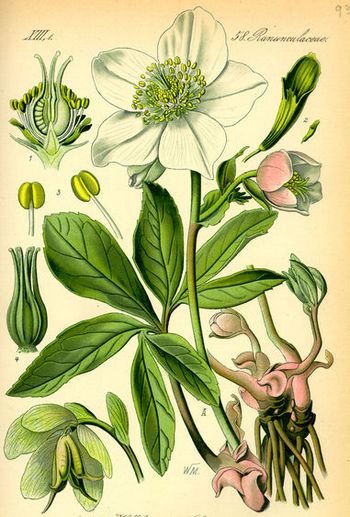Frost fragrant – Helleborus odorus Waldst. And Kit.
Семейство buttercup - Лютиковые
Hellebore smelly - description of the plant
Perennial herb with creeping rhizome branched brown. Stems upright, green, height 30-60 cm. Basal leaves usually die in winter; they are single, on long stalks, palchatorassechennye at 7-16 ovate, lanceolate, leathery, krupnopilchatye slices; stem leaves smaller, sessile. Tsvetkov 2-4 at the end of the stem. Perianth simple, from 5 ovate, light green or blue-green petals. The stamens are numerous. Fruit assembly, several seeded, plane at the tip of the tapered bubbles. Blooms in January / February - April.
Spread. It grows among bushes, light woods, in the foothills and in the mountains. It is found in Central and South-Eastern Europe.
Raw materials. The dried rhizome with lots of roots, which are typically located only on one side of the rhizome. Their color is dark brown, malodorous, by sladkovatogo gorykovyazhushtego to taste.

The content of active substances in the fragrant hellebore
Cardio-active glycosides (ʙufadienolidы): gellebrin, dezglikogellebrin, Gel lebrigenin (aglycone), steroid saponins, fatty oil, etc..
The main effect of drug hellebore
Cardiac; Local anesteziruyushtee.
Experimental and clinical evidence of therapeutic action hellebore
Established, glycosides that hellebore odorous have significant cardiotonic activity, which exceeds almost 10 Activity time digitalis glycosides and 3,5 fold lower activity strophanthin. By the nature of their actions, they are closer to glycosides strophanthin, than digitalis glycosides. Calcium ions potentiate the effect of glycosides hellebore, potassium ions and reduce their toxicity. In experiments in vivi and established in vitro, hellebore glycosides that have a stimulating effect on the smooth muscles of the intestine. Analysis of the mechanism of this action can be attributed to it at the expense caused by the release of serotonin. Other, primary, established in experiments property glycosides hellebore is their local anesthetics action, characterized by slow manifestation (8-15 Minutes) and long duration (1-3 Hours). Combined use with cocaine solution glycosides and dikainovym solution leads to mutual potentiation of anesthetic effect.
Pharmacological studies confirm cardiotonic and diuretic effect of another species of hellebore Helleborus niger. At the same time highlights, especially high doses it can cause poisoning, characterized by the presence of acute gastrointestinal symptoms, ʙradikardiej, atrioventricular block. New research shows, that parenteral use the full extract of hellebore in the form of infiltration leads to selective accumulation of it in the larger nerve trunks, and after 6-8 minutes after its stops completely nerve conduction. Evolving induced analgesia lasts longer and procaine xylocaine anesthesia.
Hellebore glycosides also have a calming effect and intense, that can be related to their influence on serotonin metabolism. Interest is set recently in experiments in vitro cytotoxic and expressed a strong antiviral effect of aqueous extracts from the rhizome Helleborus niger.
Application hellebore in folk medicine
In folk medicine, hellebore rhizome boiled in vinegar, applied topically for hair loss, Dandruff, to strengthen the hair, for washing festering wounds, etc.. It should be taken into account, that hellebore is very toxic plant and should be avoided its application.
Note. From the rhizome grows in the southern and south-western areas of species of hellebore Helleborus purpurascens W. And K. isolated glycoside korelborin, which is used as a cardiotonic drug in the form of tablets and capsules. Korelborin in its chemical structure is part of a subgroup glycosides sea onion. The speed of the effect it is close to strofantinu, and on the duration and cumulative properties - to digitalis.
